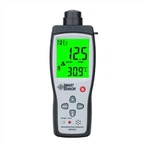Introducing the Illuminance Meter and How It Works
1. Illuminometer:
An lux meter, also known as a lux meter, is a specialized instrument for measuring luminosity and brightness. It is to measure the intensity of light (illuminance)
It is the degree to which an object is illuminated, that is, the ratio of the luminous flux obtained on the surface of the object to the illuminated area. An illuminance meter is usually composed of a selenium or silicon photovoltaic cell and a microampere meter.
2. Measurement principle:
A photovoltaic cell is a photoelectric component that directly converts light energy into electrical energy. When light is incident on the surface of the selenium solar cell, the incident light passes through the metal thin film 4 and reaches the interface between the semiconductor selenium layer 2 and the metal thin film 4, generating a photoelectric effect at the interface. The magnitude of the generated photocurrent is proportional to the illuminance on the surface of the photovoltaic cell receiving light. At this point, if an external circuit is connected, a current will flow through, and the current value will be indicated on a microampere meter with lux (Lx) as the scale. The magnitude of photocurrent depends on the strength of the incident light. The illuminance meter has a gear shift device, so it can measure both high and low illuminance.
Types of illuminance meters: 1. Visual illuminance meter: inconvenient to use, low accuracy, rarely used. 2. Optoelectronic illuminance meter: commonly used selenium solar cell illuminance meter and silicon solar cell illuminance meter.
What are the advantages of an illuminance meter?
Compact Size, Light Weight
The opportunities for using an illuminance meter are very wide, and the timing of application is often in different places, so a portable body with small size and light weight is the first prerequisite for an illuminance meter.
Accuracy
The quality of an illuminance meter is absolutely related to its accuracy. Of course, it is also closely related to its price, so it is necessary to buy an illuminance meter with high accuracy at a reasonable price, generally with an error of no more than ± 15%.
Color Compensation
There are various types of light sources, some of which focus on longer wavelength red high-pressure lamps, or shorter wavelength blue purple lamps such as Daylight fluorescent lamps; There are also relatively evenly distributed series such as incandescent bulbs, where the sensitivity of the same illuminance meter may vary slightly for different wavelengths, so moderate compensation is necessary.
Cosine Compensation
As we all know, the brightness of the illuminated surface is related to the incident angle of the light source. By the same token, when using an illuminance meter for measurement, the angle of incidence between the sensor and the light source will naturally affect the reading of the illuminance meter. So whether a good illuminance meter has cosine compensation function cannot be ignored.






